|
JOHNSON AND PHILLIPS LTD.
This 1917 advertisement from the back pages of a cable
textbook shows the Eastern Telegraph Company’s CS Restorer, fitted
with Johnson and Phillips cable gear. The ship is pictured on the River
Thames.
Founded in 1875 and located in Charlton, south-east London, not far from the hub of the cable industry in Greenwich, the company
offered: “Complete equipments of cable machinery, accessories and
stores for cable laying and repairing steamers.”
Their products at that time also included: “Telegraph, telephone
and insulated electric cable of all kinds” and “Machinery and
plant for electric cable manufacture”.
Brief biographies of W.C. Johnson and S.E. Phillips, the partners in the firm, are given in The Electricians’ Directory with Handbook for 1885:
Johnson, W[alter] C[laude]
(of the firm of Johnson and Phillips).
Educated at Victoria College, in the island of Jersey.
When about seventeen years of age Mr. Johnson became an articled pupil to Mr. W.F. Gooch, at the Vulcan Foundry in Lancashire, where he remained for five years. Failing, however, to find work that was congenial to his tastes, and after declining with considerable hesitation the offer of an appointment in a drawing office at the rate of £50 per annum, he resolved to join the applied sciences department, King’s College, London, for a year, and on the completion of this term he was engaged as a draughtsman by Mr. H. Clifford, the engineer of the Telegraph Construction and Maintenance Company’s works.
It was here, in working out designs for improved cable machinery, under the immediate supervision of Mr. Clifford, that he obtained a clear insight into the most advanced form and construction of this important branch of engineering, and his keen observation had ample scope, not only in the direction to which his abilities so conspicuously tend, viz., in the design and construction of machinery, but also in the laying of all the original cables of the Eastern and Eastern Extension Telegraph systems.
He was appointed chief engineer in the laying of the British Australasian cable, the expedition being commanded by Captain Halpin. He left the works of the Telegraph Construction Company to join Mr. S.E. Phillips in establishing a business of their own.
The History of Johnson and Phillips by Collin Brooks, 1950, notes that “In the October of 1876 he ended his attachment with T.C. and M, the family jotting diary cheefully noting that he had been ‘sacked’.”
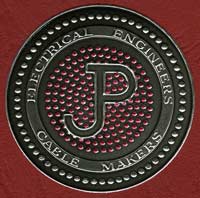
Johnson & Phillips logo
from the
1962 Annual Report |
The JP logo also appears on this mysterious item, whose function is not presently known:
If you know what this item is, please email me.
Phillips, S[amuel] E[dmund]

Samuel Edmund Phillips
c. 1890 |
Mr. Phillips, when a boy, was brought into contact with telegraphy, his father being at that time engaged with Dr. Whitehouse in carrying out experimental work in connection with the first Atlantic cable. He subsequently accompanied his father in the first Malta and Alexandria cable expedition; and he became a member of the staff which Colonel Stewart formed to go out with the Persian Gulf cable, remaining at Bushire as a junior clerk.
At the end of three years’ service he returned to England, and obtained an appointment on the electrical staff of Messrs. Latimer Clark, Ford and Co., leaving these gentlemen to become electrician to Mr. W.T. Henley, and in whose service he remained for ten years.
At Mr. Henley’s works he was appointed manager of the cable department, and occasionally he accompanied some of the cable expeditions as the head of the electrical department. As an inventor Mr. Phillips has given us a fluid insulator, which has been largely adopted in India. In 1875 he joined Mr. W.C. Johnson in partnership, and a small works was established at Charlton.. This formed the nucleus of the present extensive range of factories.
The address of the firm was given in 1885 as 14, Union-court, Old Broad-street, E.C., and Victoria Works, Charlton, S.E.
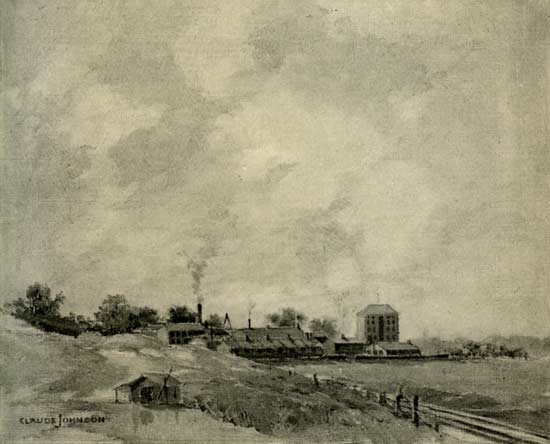
Oil painting of the Works in 1877 signed Claude Johnson |
In 1872, Phillips’s father, Samuel Elkins Phillips, collaborated with Wildman Whitehouse on GB patent 1872 / 3,016 “Recording fares in public vehicles”. The elder Phillips had been associated with Whitehouse since the early days of the first Atlantic cable project in the 1850s.
Samuel Phillips died at the age of 45 on 22 July 1893, and it was left to Claude Johnson to continue the company, which he did with great success.
In its edition of 5 August 1892 The Electrician published this expanded biography of Johnson together with a photograph:
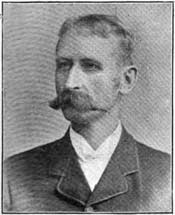
Claude Johnson |
Johnson, W[alter] Claude, M.I.C.E., at the age of seventeen was articled to Mr. W.F. Gooch, C.E., serving five years’ apprenticeship in the locomotive works of the Vulcan Foundry, after which he studied at King’s College, London. From 1869 to 1875 he was with the Telegraph Construction and Maintenance Company, and acted in various capacities both at the works and in cable-laying expeditions. Here he became thoroughly conversant with the requirements of cable laying and picking up; indeed, so close was his study of the subject that he soon became recognised as the leading authority dealing with such apparatus. Hence, when in 1875 he joined Mr. S.E. Phillips, to form the firm of Johnson and Phillips, that firm took a commanding position in the manufacture of all cable apparatus, and from that time to this the firm has probably designed, or, we should say, Mr. Claude Johnson has designed, and the firm constructed, the largest part of the cable machinery existing.
Mr. Claude Johnson controls Charlton Works, which have steadily increased in size, and are still being added to. These works now cover an area of seven acres, and employ about 500 men. Latterly, the developments of electric lighting have overshadowed those of cable work, and the larger part of the works is devoted to lighting requirements, although just at present they are busy with cable machines designed for M. Grammont’s factory in France, and other work for the Eastern Telegraph Company. It speaks much for the capacity of Mr. Claude Johnson as an engineer and as an organiser to see the admirable way in which those works are conducted. He has had the great advantage of being well supported by his scientific partner, Mr. S.E. Phillips.
Literary and professional men are generally supposed to owe much to having sat at the feet of some Gamaliel, till it seems a pity that it was not fashionable for a successful business man to be surrounded with a bevy of learners. Of this firm it might be said that it pursues the only true course to ensure permanent success: it undertakes nothing it cannot perform, and is satisfied with none but the very best workmanship and materials. This speaks volumes for the heads and hearts that guide the venture.
The first we know of Johnson’s interest in the arts is his 1877 oil painting of the J&P factory shown above, which was reproduced in the 1950 book on the company, The History of Johnson and Phillips. The location of the original is not known.
His 1928 obituary in the Journal of the Institution of Electrical Engineers, of which he became a member in 1875, notes that:
“Apart from his business activities he took a great interest in matters artistic. Himself a painter of no mean order, in 1901 he founded The Connoisseur, a leading magazine of art known all over the world.”
Site correspondent Steve Beare has in his collection this oil painting of another industrial subject by Johnson, signed and dated on the reverse “The Canal at Birmingham by W Claude Johnson 1908”.
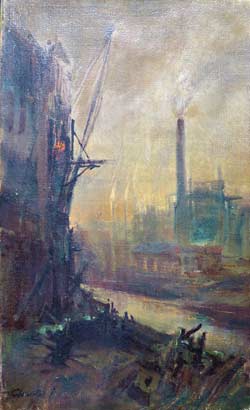
Oil on canvas, 6" x 10"
|

The Canal at Birmingham
by W Claude Johnson
1908
Images courtesy of
Collection of Steve and Karen Beare |
Although described in his obituary as “a painter of no mean order,” Johnson is not recorded in directories of artists from that period. A search of current art price databases finds only two further oil paintings identified as by W Claude Johnson, and both may be by a later artist of the same name, as the signature on one of these paintings is not the same as that on either of the paintings shown above, and the artist’s dates for that work are given as 1905-1991.
| Ships fitted out with
cable machinery by Johnson & Phillips |
| 1882 |
Viking (1) |
Western & Brazilian Telegraph Company |
| 1883 |
HMTS Monarch (2) |
GPO |
| 1883 |
Volta |
Eastern Telegraph Company |
| 1884 |
Electra |
Eastern Telegraph Company |
| 1884 |
Magneta |
Eastern Extension, Australasia & China
Telegraph Company |
| 1886 |
Citta di Milano (1) |
Italian Government |
| 1889 |
Chiltern |
Telegraph Construction & Maintenance
Company |
| 1889 |
Relay |
Central & South American Telegraph Company |
| 1889 |
John Pender (1) |
Eastern Telegraph Company |
| 1892 |
Great Northern |
Eastern & South African Telegraph Company |
| 1895 |
Okinawa Maru |
Japanese Government |
| 1896 |
Admiral Caubet |
French Government |
| 1896 |
Tutanekai |
New Zealand Government |
| 1898 |
Von Podbielski |
Norddeutsche Seekabelwerke |
| 1901 |
Viking (2) |
Amazon Telegraph Company |
| 1901 |
Lady Laurier |
Canadian Government |
| 1902 |
Pacific |
Great Northern Telegraph Company |
| 1903 |
Patrol |
Eastern Extension, Australasia & China
Telegraph Company |
| 1903 |
Restorer |
Eastern Extension, Australasia & China
Telegraph Company |
| 1905 |
Ogasawara Maru |
Japanese Government |
| 1905 |
Burnside |
United States Army |
| 1907 |
Guardian |
Central & South American Telegraph Company |
| 1909 |
? |
Australian Government |
| 1911 |
Ramos |
Amazon Telegraph Company |
| 1912 |
Edouard Jeramec |
La Compagnie Française des Câbles Télégraphiques |
| 1913 |
Princess Louise |
Canadian Government |
| 1914 |
Transmitter |
Eastern Telegraph Company |
| 1915 |
Hodder |
GPO |
| 1920 |
Edouard Suenson |
Great Northern Telegraph Company |
| 1921 |
Store Nordiske |
Great Northern Telegraph Company |
| 1921 |
? |
Japanese Government |
| 1922 |
Kilmun |
Admiralty Cable Service |
| 1922 |
Dellwood |
United States Army |
| 1923 |
Silvergray |
India Rubber, Gutta Percha & Telegraph
Works Company |
| 1923 |
Nanyo Maru |
Japanese Government |
| 1923 |
Mirror (2) |
Eastern Telegraph Company |
| 1923 |
Norseman (4) |
Western Telegraph Company |
| 1924 |
Cable Enterprise (1) |
Western Telegraph Company |
| 1924 |
Zuiderkruis |
Dutch East Indies Government |
| 1937 |
Lasso |
Admiralty Cable Service |
| 1939 |
Mernoo |
Australian Government |
| 1939 |
HMTS Ariel |
GPO |
| 1940 |
HMTS Iris (2) |
GPO |
| 1940 |
Bullfinch |
Admiralty Cable Service |
| 1940 |
Straide |
Admiralty Cable Service |
| 1940 |
Dunavon |
Admiralty Cable Service |
| 1940 |
Castlerock |
Admiralty Cable Service |
| 1940 |
? |
Admiralty (Singapore) |
| 1940 |
Cecile Mapleson |
Admiralty Cable Service |
| 1942 |
Holdfast |
Admiralty Cable Service (Pluto) |
| 1942 |
HMS Retriever |
Admiralty Cable Service (Pluto) |
| 1942 |
Bulan |
Admiralty Cable Service |
| 1942 |
Sprayville |
Admiralty Cable Service |
| 1942 |
Castillo Olmedo |
Spanish Government |
| 1943 |
St Margarets |
Admiralty Cable Service |
| 1943 |
Bullfrog |
Admiralty Cable Service |
| 1943 |
Bullhead |
Admiralty Cable Service |
| 1943 |
Algerian |
Admiralty Cable Service (Pluto) |
| 1943 |
Sancroft |
Admiralty Cable Service (Pluto) |
| 1943 |
Latimer |
Admiralty Cable Service (Pluto) |
| 1944 |
? |
Australian Government |
| 1946 |
Edward
Wilshaw |
Cable & Wireless Ltd |
| 1947 |
Sørkabel |
Norwegian Government |
| 1948 |
Nordkabel |
Norwegian Government |
| 1948 |
Poolster (2) |
Netherlands Government |
| 1952 |
Stanley Angwin |
Cable & Wireless Ltd |
| 1953 |
Ocean
Layer |
Submarine Cables Ltd. |
| 1955 |
Recorder
(3) |
Cable & Wireless Ltd |
| 1957 |
Telekabel |
Norwegian Government |
| 1961 |
Retriever
(5) |
Cable & Wireless Ltd |
| 1962 |
Mercury |
Cable & Wireless Ltd |
| 1964 |
Cable
Enterprise (2) |
Cable & Wireless Ltd |
| Thanks to Bill Glover for
researching this list |
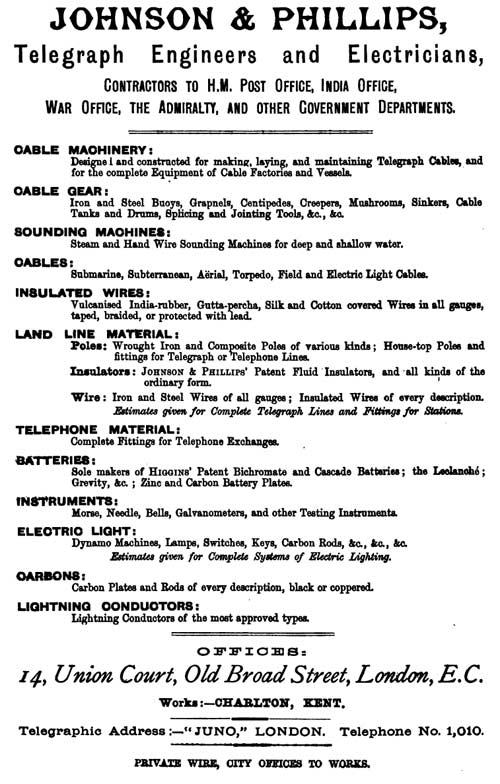
Johnson & Phillips advertisement from the 1885 Electricans' Directory
|
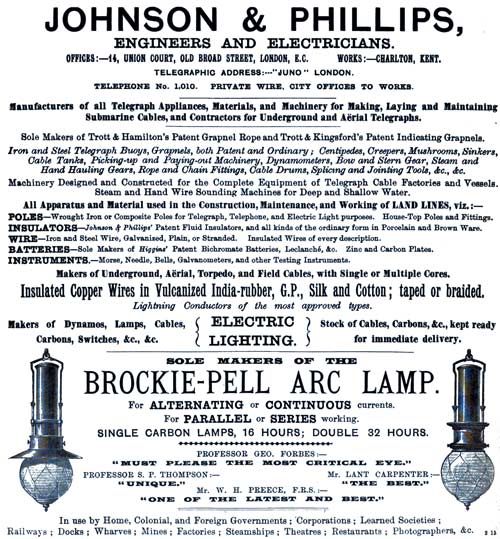
Advertisement from
The Telegraphic Journal and Electrical Review
26 December 1890 |
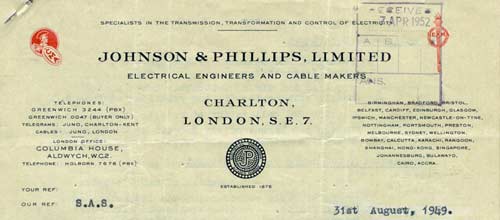
1949 Letterhead
Image courtesy of Brenda Batho |
_s.jpg)
1961 Letterhead
Image courtesy of Ian Merry |
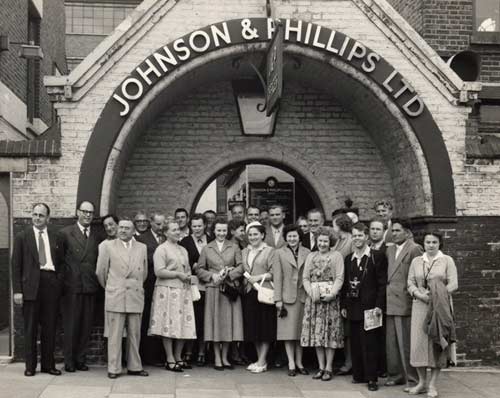
1960s staff photograph outside the main entrance of the factory
Image courtesy of Brenda Batho, whose father (front row left)
worked at J&P from
1947 until the late 1960s |
_s.jpg)
S.E. Phillips Memorial - July 2008
In Memoriam Samuel Edmund Phillips
Born April 9th 1848. Died July 22nd 1893
"Write me as one who loves his fellow men"
The memorial is located on the south side of
Shooters Hill
on the western slope of the hill.
Photograph courtesy of John Poulton,
licensed under Creative Commons.
|
In 2012 site visitor Dave Webb shared these memories of the firm:
Johnson and Phillips was always a family business. Fathers, sons, uncles, aunts – whole generations of families worked there. My father (Frederick Ernest Webb) worked for them from the thirties until he was made redundant in the late 60s. He worked in the testing department in the paper cable factory (the largest one on site) based at the north end of the plant in Charlton. His service was only interrupted by war service in the forties. He loved the job, the company and the relationships he formed with many other employees. Like many other redundant workers he found it hard to settle into other jobs after. I can remember going to the children’s Christmas parties there as a child.
I joined the company on September 1st 1965 as a trade apprentice. I spent a year in the apprentice workshop run by Jock Craigie and Joe Lower. I then went into the maintenance department. In 1967 the change in accounting techniques meant that companies were closing everywhere. J&P sold the paper cable plant and the New Cross factory, just keeping the rubber cable factory. I moved into the top yard, still in the maintenance department. There were many changes of names. Enfield Standard Power Cables, Enfield Cables, Delta Cables. After completing my apprenticeship in the drawing office, I left in 1972. A long and happy time, and I am still working with another old J&P guy!
The Greenwich Industrial Heritage Society's archived website has some reminiscences from a J&P employee who started with the company in 1929. The article notes that the firm was taken over by Enfield Cables and then Delta Metal.
Details of the later history of the various parts of Johnson & Phillips are hard to find. For example, the 100th anniversary book on electrical manufacture MEM mentions that Delta Metal acquired Johnson & Phillips (Capacitors) in 1967, and in 2003 Delta's Electrical Division was acquired by Eaton Corporation, but no further details are given on J&P.
As Dave Webb notes above, Johnson & Phillips traded into the 1970s but is no longer in business. If any site visitor can provide further details of the company's last years, please email me.
|

